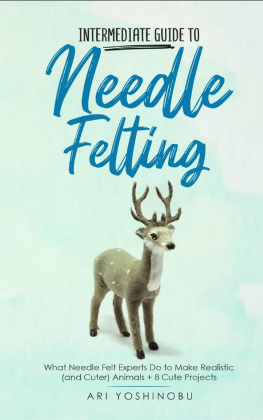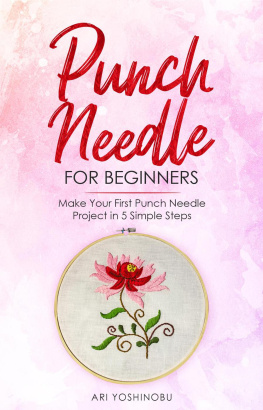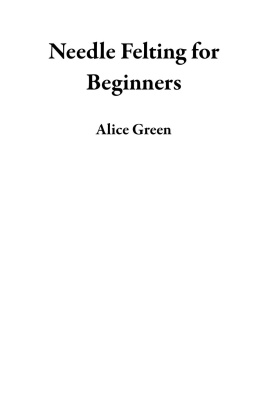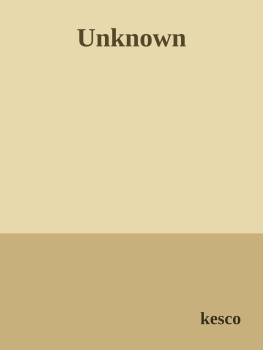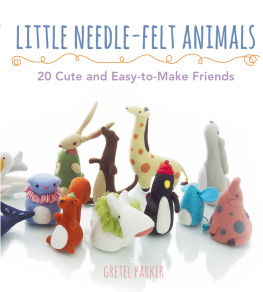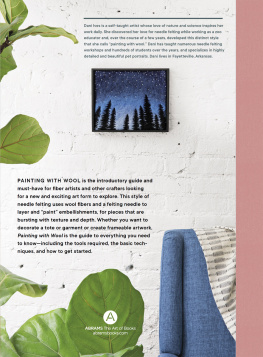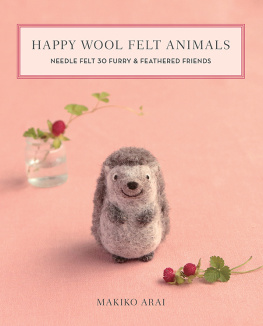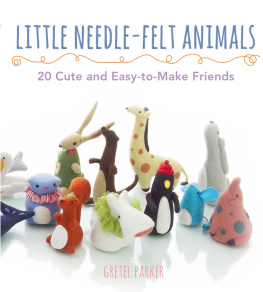INTERMEDIATE GUIDE
TO
NEEDLE FELTING
ARI YOSHINOBU
Copyright 2020 - All rights reserved.
The content contained within this book may not be reproduced, duplicated or transmitted without direct written permission from the author or the publisher.
Under no circumstances will any blame or legal responsibility be held against the publisher, or author, for any damages, reparation, or monetary loss due to the information contained within this book, either directly or indirectly.
Legal Notice:
This book is copyright protected. It is only for personal use. You cannot amend, distribute, sell, use, quote or paraphrase any part, or the content within this book, without the consent of the author or publisher.
Disclaimer Notice:
Please note the information contained within this document is for educational and entertainment purposes only. All effort has been executed to present accurate, up to date, reliable, complete information. No warranties of any kind are declared or implied. Readers acknowledge that the author is not engaged in the rendering of legal, financial, medical or professional advice. The content within this book has been derived from various sources. Please consult a licensed professional before attempting any techniques outlined in this book.
By reading this document, the reader agrees that under no circumstances is the author responsible for any losses, direct or indirect, that are incurred as a result of the use of the information contained within this document, including, but not limited to, errors, omissions, or inaccuracies.
Table of Contents
C ongrats on your completion of the beginners guide, and welcome to the very first stages of completing your intermediate guide! It makes me so happy to see you here with me again. We have come a long way together, and I hope you are as excited to jump into this new guide as much as I am!
One of the best parts about learning needle felting is that there is never a shortage of things to learn. This is what I love most about this skill and art form; yes, before you ask, it is an art form. I hope that you view your work as art too. A lot of hard work and technical skill goes into making each little creature or figure; those ideas are the very foundation of what art means. There is a lot of destruction in the world: to make something and put it forth into the world is truly special. I hope that you see how much good creative expression does for you and for everyone else around you.
Before we jump into new material, how about we take a moment to review what we learned in the beginners guide. Since we covered so much in the first guide, it is good to take this moment to refresh what you know before we jump into new projects.
In the beginners guide, we learned what needle felting is and how the basic principle is relatively simple. All you need to complete a basic structure is a piece of wool and a barbed needle. However, we do not want to stick to making basic structures all the time, do we?
After that, we jumped into the necessary tools needed to complete a felted figure. We mentioned wool and a barbed needle already; the last tool needed is a surface to felt on.
Now, let us test your memory. There are four different types of felting needles: can you name them? Try your best to name them here, and I will include the answers at the end of this section. No peeking!
We also reviewed the different types of wool available. What is your favorite wool that you have used so far? Which wool are you most excited to try out? I love how each wool lends a different texture and feel to each new project. Even if you make the same shape over and over again, using different yarns will result in different products. How fun is that?
Finally, we jumped into some super cute projects together. What was your favorite project that we completed together? Are there any projects that you skipped over? If so, I greatly encourage you to go back and try whichever task you skipped. Did you struggle with any projects or techniques in a task? Again, I strongly encourage you to go back and try them again. As Im sure you know, practice makes perfect. Each of the projects listed in the beginners guide are made to teach you vital skills that will help you improve your needle felting projects. By going back and trying difficult techniques or structures multiple times, you are building a stronger understanding and will help you build a stronger technique. Naturally, and over time, you will get better and your hard work will pay off; that is the whole reason you are here in this intermediate guide, right?
Now that we have reviewed the information we learned in the beginners guide, let us now get to learning new skills! In this guide, we will learn how to make some advanced shapes and work toward making realistic figures. Here, we are going to focus on super cute animal projects with a few that we can alter to reach peak cuteness!
As in the beginners guide, each of these projects were carefully selected to help you improve your skills. These projects build on the foundation that you formed in the beginners guide and introduce you to new techniques, new wool fibers, and even a few new tools! I have also included a hand section of tips, tricks, and advice for you to check out. Keep this section close by as I will make references to it during the individual projects. These tips, tricks, and advice are not one size fits all: these are things that work great for some people but may not work the best for everyone. I encourage you to at least try them out and modify the suggestions in a way that feels natural to you.
If your goal is to focus on more realistic figures, I included photos of the real animals in natural colors and settings to give you an immediate reference. This will save you the trouble of having to do an Internet search to see what an ermine looks like and then fall into an Internet hole after you discover how cute their little faces are and completely ignore your needle felting project. We do not want this, so I made it simple for you to help you along your journey.
If you are still feeling a little weak on your feet in regard to your needle felting ability, I encourage you to start out by making the projects as they are written. Having that step-by-step instruction to keep flipping back to will help you gain confidence in your abilities. Once you feel more confident, try out some of the tips and tricks in the projects, or alter the instructions slightly to create a figure that is truly your own.
That being said, there are opportunities to take all of these projects a step further. At the end of each project, I list some ideas of how you can modify the figures to create different and related creatures. These are just suggestionsyou by no means have to follow them. They are there just to spark your creativity and encourage you to think about projects in different ways. I hope you like the ideas, and I hope they help you think of other ways that you can use these projects to create even more projects! If you think of ideas, feel free to jot them down so that you do not forget them later on.
Most importantly, as you start to dive into these projects, take your time going through them. Learning how to needle felt is a marathon, not a sprint. If you rush through all of the projects, you are going to make mistakes and break a few needles, which will lead to frustration. Rushing is not necessary, and frustration is certainly not ideal. Slow and steady practice is much more relaxing and enjoyable! Take your time and enjoy making nine new little creatures!
Next page
